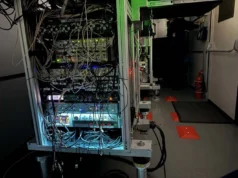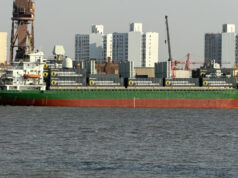The UK has awarded contracts for a number of Autonomous Underwater Vehicles, including drones able to submerge to 1,000m.
The £6Mn worth of orders includes two 1,000m depth capable Gavia Offshore Surveyor AUVs and three IVER 4 580 AUVs.
The first purchase was three Iver 4 580 model underwater vehicles. According to the manufacturers, the Iver4 580 offers users a 300-metre depth survey system featuring hot-swappable battery sections that can be changed in the field without any special tools.
The Royal Navy also purchased two larger ‘Gavia’ underwater drones that can reach depths of 1000m and meet survey standards. They are portable and have a modular design that allows for interchangeable survey modules and batteries. The drones have various survey capabilities, including Side-Scan Sonar, Multi-Beam Echo Sounder, and Acoustic Doppler Current Profiler. They also have an Ultra-Short Baseline positioning system, Sub-Bottom Profiler, and an option for a CTD Oceanographic module. There are options to purchase additional survey modules.
According to their builders, the Gavia Offshore Surveyor AUV is a self-contained, low logistics survey tool capable of delivering high-quality data while operating from vessels of opportunity or even from the shore.
Typical commercial applications include: Bathymetric surveys, Environmental surveys, Exploration and various construction support and inspection tasks for pipelines and platforms utilising side scan, camera and swath bathymetry or specialised payloads.
Project HECLA
The underwater vehicles are being procured as part of Project HECLA, which was established to optimise the Royal Navy’s ability to collect and exploit hydrographic and oceanographic information. Previously, Project Hecla looked at the use of underwater gliders.
The ocean environment is a dynamic and evolving system, and what was understood 20 or 30 years ago no longer holds true in many areas, particularly in the North Atlantic, which is a critical zone for submarine operations and one of the most intricate and challenging bodies of water.
Key factors such as salinity, sound velocity, and temperature have undergone changes, and it is essential to obtain accurate information to enhance our comprehension of the underwater environment or battlespace. Such insights enable the optimisation of ship and submarine sensors and provide an operational edge.
The Royal Navy aims to deploy autonomous underwater vehicles continuously in high-threat areas to provide a persistent and accurate situational awareness of the underwater battlespace. This will allow for timely operational decision-making based on the latest information.
The availability of this information in a timely manner is particularly important for submarine-hunters, such as the Type 23 Frigates or the P-8 Maritime Patrol Aircraft fleet, as it will enable them to adapt and respond better when detecting underwater surface threats.
















Small numbers but its a start. These do appear to be very capable pieces of kit that I guess will be used by the new MROS vessel currently fitting out at Cammell Laird.
The cost of these things is such that they could be purchased using underspends, so perhaps possible to increase numbers or perhaps some extra modules if the opportunity presents itself.
Cheers CR
One wonders what could be achieved with competent leadership and a bit of vision. Million dollar drones replacing billion dollar submarines and frigates.
Not a replacement for the SSN’s, they are an addition, and a vital one at that.
Wow so the Royal Navy is actually buying drones that will actually be used in operation as opposed to another decades worth of on again off again trials.
Next we could just buy a dozen offshore support vessels and paint then gray and Walla we have a major fleet component for less than £1 billion that can do everything from MCM to disaster relief and even secondary ASW and sea control.
We desperately need an equivalent to HECLA for arial drones where we buy small numbers of off the shelf solutions and deploy them rather than the multi year multi billion dollar “proper” acquisition programs the MOD is use to with multiple four letter abbreviations and lots of jobs for the boys at the end.
We are currently wasting precious Merlin helicopters on AEW when off the shelf drones are already available being a prime example.
Buying off the shelf in this case is really a good no brainier to add capability quickly. The RN has turned serious about getting reasonably priced capabilities to monitor our underwater infracture…I suspect Russia sabotaging the gas pipeline last year was a bit of a shake up….sudden realisation Putin is capable of doing almost anything to western infrastructure if he thinks he can have some deniability.
Like the undersea cable that was mysteriously cut last year off Shetland?
https://www.businessinsider.com/uks-remote-shetland-mysteriously-lose-phone-internet-after-cable-cut-2022-10?r=US&IR=T
it snapped off in my hand honest.
Love to know what gear off the shelf drones are that will be suitable for AEW
Protector
GD already advertising it
https://www.ga-asi.com/remotely-piloted-aircraft/mq-9b-skyguardian
Sadly we have discussed this before. Unless you use a network of four or more of these drones, anything less won’t work, especially for carrier based AEW.
The reason for this is small airframe size along with the low electrical generation. The smallish airframe and power plant place a constraint on the type and size that the drone can operate.
The MQ9 is limited to using a X-band radar. But its power output is tied to the engine’s ability to generate electricity. Which therefore limits the number of arrays it can use as you want the single array to be able to detect as far as possible.
The issue is the number of drones needed for 24/7 ops. The MQ9 Sea Guardian drone can stay up for at least 14 hours with a max of 18 hours, depending on its payload. But it is the range of the X-band radar that compromises things. At a max of 200 up to 250 miles. A single aircraft much like a Crowsnest Merlin can only produce a limited bubble around a carrier. To get more you will need more aircraft preferably four networked to the carrier. Which would give a 800 mile bubble. But then you will need another four aircraft to replace these, when they’re low on fuel. With at least two more as spares. Making at least 10 aircraft.
However, if you use a much larger drone, you can install a larger radar preferably operating in the S or L band. Which gives you the near 400 miles detection range. Which then reduces the number of airframes needed. Furthermore as the bubble has been pushed out beyond the 20@ to 250 mile range. It makes the AEW aircraft much safer, as it will detect missiles earlier. Which therefore means the carrier’s CAP aircraft can operate further from the carrier.
For me the MQ9 is a red herring. It will takes us down the wrong path for carrier based AEW. We need a larger aircraft that can carry a larger lower operating frequency radar. Which can push the detection bubble much further out from the carrier. I have an idea on the aircraft and it could kill two birds with one stone.
What AEW drones are available?
Depending upon the actual purpose ie quasi military surveying at one end to serious military information gathering and attack at the other would dictate that I presume. Off the shelf aerial drones and even US Raven drones in Ukraine have poor survivability in a heavily radio countermeasured environment perhaps three flights apparently, while certain military drones like Atlas produced models are fundamentally immune from Russian jamming. Is it potentially similar underwater? So I would presume there will have to be a mix of off the shelf, modified and strictly and no doubt extremely expensive military produced models aimed at different jobs and different environments.
Protector
https://www.ga-asi.com/remotely-piloted-aircraft/mq-9b-skyguardian
Protector in RAF service is an ISTAR asset and won’t be used in the AEW role. It also isn’t carrier capable.
MQ 9b in sea guardian add-on kit is carrier capable.
I can’t see anything that says its carrier capable.
Just google Sea Guardian STOL drone.
Ok, found it, but I don’t think a real one exists yet, or has completed any carrier trials at sea.
Seems for once they have brought something using the 80/20 rule. 80% capability of what they wanted for 20% of the price of a gold plated version. As Jim stated in his comments, not all our ships need to be top of the range and able to survive EM attacks etc. I once worked on a project where they expected our appliqué kit to work at -32 degrees, when the piece of plant it was going on, wasn’t capable of operating below -23 degrees. Don’t waste loads of time and money on the once in a life time, when you could buy stuff in quantity that is able to meet 95% of your requirements.
Is it just me that thinks that the RN seems to running rings round the other 2 services ? It isn’t just funding it seems to me that there is a whole new mindset of “Can do, will do, done” and they aren’t afraid to do a bit of lateral thinking.
The Ship building strategy seems to be working well, capacity is increasing and replacement of high end kit is being ordered and delivered.
Plus they are leveraging Civilian industry and tech to deliver capabilities at cost, on time and at Pace.
We have excellent Offshore Support and Deep Sea Industries courtesy of Gas, Oil and Offshore Wind so using Offshore Support Vessels and commercial drones is delivering a new capability and it is scalable.
When you compare this to how other countries are tackling the same issues it is quite interesting. The US is going to use its LCS2 as MCM motherships, that is a $650 million ship, with a Helicopter pad and capable of 40 knots. Europe are building cheaper purpose built Motherships.
But for the RN it’s the LEGO & Meccano approach so what’s not to like ?🤓
There are major issues and they can’t be fudged, munitions supply / stock levels, accommodation, support infrastructure and we very badly need more F35’s, Helicopters and trained Aircrew.
Oh and an Aircraft Carrier that keeps breaking 😡
I think they are running rings and seem to be in better shape. They do have some problems t o fix as you listed. My main one that is bugging me is why we spend £20m for a single Schiebel 100 drone and we already don’t have a whole fleet of them – they supposedly cost 2 million per 2 for a containerized set up.
It’s more than one Schiebel 100 drone. Most commentators think 8-10 is the reasonable estimate. Although obviously this remains under wraps. The drones are sold in pairs with their control/ interface and some spares, servicing and training integral to the purchase.
RN has always been highly adaptable , flexible and able to think laterally. RAF and Army could learn from the comments above which I agree with 80/20 rule. Buying off the shelf proven designs etc etc.
The key aspect is how the RN has bought off the shelf with a vision of how multiple systems can work together.
Walk to work ships, Topaz Tobragos. USVs together delivering surveillance of offshore nationally critical infrastructure. Just need to scale these programmes up, once proven in service and buy more of it for really good value for taxpayers money.
The strategic oil and gas installations in the North Sea must be protected against Russian aggression.